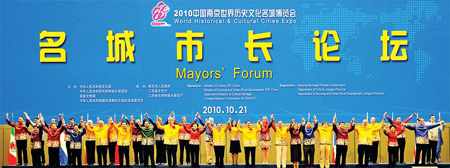Long history of working with foreigners
|
The Mayors' Forum at the 2010 Nanjing World Historical and Cultural Cities Expo. |
Nanjing is no newcomer to the opening up to the outside world since it was previously the capital of 10 dynasties and has a very favorable geographical location with rivers and sea passing by.
It dates back to 300 BC when the city began cultural and trade exchanges with Korean peninsula, Japan, Southeast Asian countries and Persian and Roman Empire.
Between 1405 and 1433, the great Chinese navigator Zheng He led fleets to the sea from Nanjing seven times and visited more than 30 countries and regions in Asia and Africa by passing through Southeast Asia, the Indian Ocean and reaching the Red Sea and the east coast of Africa.
With the door opening wider to the world since the 1980s', more than 1 million overseas tourists and business people travel to Nanjing every year. Besides, about 13,000 foreigners work, study and reside in Nanjing on a long term. They have made great contributions to the city's economic and social development. So far the government has awarded the title of "honorary citizen" to 71 expatriates.
In terms of foreign exchanges, Nanjing has taken the lead in many areas.
In 1978, Nanjing Little Red Flower Art Troupe became the first Chinese children's art troupe that visited the foreign country. It has paid over 20 visits to Europe, Asia, America and Africa, and performed for state heads and foreign delegations visiting Nanjing.
In 1981, the Johns Hopkins University-Nanjing University Center for Chinese and American Studies was set up. It is the first teaching and research institution jointly sponsored by China and the United States after China's opening-up and reform drive in 1978.
So far it is still the largest educational cooperation project between the two countries.
International friendship cities act as a bridge between cities in different countries. Since 1978, Nanjing has established friendship city relationships with Nagoya (Japan), St. Louis (US), Florence (Italy), Eindhoven (Netherlands), Leipzig (Germany), Mexicali (Mexico), Limassol (Cyprus), Daejeon (South Korea), London (Britain), Perth (Australia), Bloemfontein (South Africa), Barranquillita (Columbia) and Melaka (Malaysia) and has established economic cooperation agreements with 14 cities and regions including Kobe (Japan), Stuttgart (Germany), Birmingham (UK), Alsace (France) and Melbourne (Australia).
The friendship city agreement with Nagoya is the first concluded between a Chinese and Japanese city after the signing of the 1978 Sino-Japan Friendship Treaty, and Nanjing's agreement with St. Louis is the first concluded between two cities in the US and China.
In recent years, Nanjing has hosted many large-scale events and activities to promote its cooperation and exchange with foreign countries in the areas of trade, business, science, culture, education and tourism.
Among such events, the Nanjing World Historical and Cultural Cities Expo has become a platform to demonstrate the city's rich culture and features. For instance, altogether 44 mayors from 16 countries participated in the 2010 Nanjing World Historical and Cultural Cities Expo, including Paris, Rome, Berne, Gottingen, Perth, Nagoya, Osaka and Olympia. Other events like the China Nanjing International Chess Super Tournament, the China International Service Outsourcing Conference, the China Nanjing International Software Fair and the Nanjing International Plum Blossom Festival have also become well-known brands for Nanjing's interaction with overseas visitors.
(China Daily 06/01/2011 page39)















